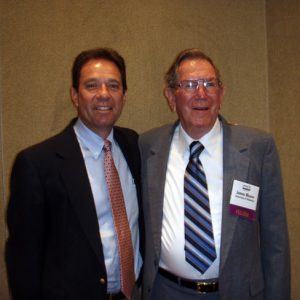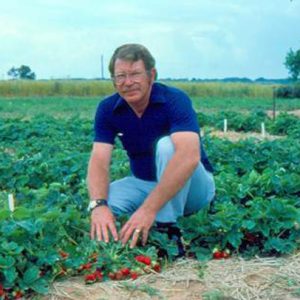calsfoundation@cals.org
James Norman (Jim) Moore (1931–2017)
James Norman (Jim) Moore bred a number of fruit species to be more easily grown in Arkansas. One of the world’s leading authorities on small fruits and a well-regarded professor at the University of Arkansas (UA) in Fayetteville (Washington County), he co-wrote the field-changing Advances in Fruit Breeding (1975) and formed the University of Arkansas Division of Agriculture Fruit Breeding Program, which became the most productive in the world of horticultural science.
Jim Moore was born on June 10, 1931, in Plumerville (Conway County) and grew up in Vilonia (Faulkner County). Moore earned a BSA in 1956 and an MS in 1957 from the University of Arkansas. He married Jan Moore before they moved to New Jersey in 1957 for his studies at Rutgers University; they had two children. He earned his PhD from Rutgers University in horticulture, having studied under famous fruit breeder Fred Hough, in 1961. “Getting into horticulture was a fortuitous thing,” Moore once commented. “My career was made because of a contact through New Jersey.” He met his life-long collaborator, Jules Janick of Purdue University, while doing doctoral work at Rutgers. There, Moore began a strawberry breeding program while his advisor was on sabbatical. The responsibility of the position gave him the relevant experience to later create the Agriculture Experiment Station at UA.
His first job was a position that required considerable travel to individuals’ farms, working for the U.S. Department of Agriculture’s Agricultural Research Service (USDA-ARS) in Beltsville, Maryland, from 1961 to 1964. He returned to UA as an associate professor in 1964, teaching small fruit production and advanced plant breeding. Moore remained on the UA campus until his retirement in 1997.
Moore began the UA Division of Agriculture Fruit Breeding Program in 1964 and served as director for thirty-three years. The program is the most productive in the world of horticultural science. He developed better varieties of fruit for growers, particularly in the South. During his time as director, the center produced more than forty cultivars of peaches, table grapes, blackberries, strawberries, blueberries, and more.
Blackberries constituted the most extensive part of Moore’s research and development. He cultivated thirteen strands and named each after Native American tribes. The Navaho strand, for which he won the Outstanding Cultivar Award, took more than ten years to develop. It was the first erect thornless blackberry in the world and was unique for tasting sweet, instead of tart or sour like all other strands. The work of his team also spurred the development of blueberry and table grape production in Arkansas. They cultivated seven strands of grapes, including Venus, Reliance, and Mars, as well as two strands of blueberries, the most notable being Ozarkblue, which was UA’s first blueberry release. Moore’s work with the blueberry growers’ association significantly boosted Arkansas economy. The association, which previously had approximately fifty members, quadrupled its membership and increased revenue to $850,000. Less than two years later, the association membership continued growing and revenue boasted $2 million.
In late 1975, Moore issued his book Advances in Fruit Breeding, which essentially replaced the USDA Yearbook of Agriculture (1937), which had been the dominant source on the subject. Other publications include The Effect of Irrigation, Spacing and Fertilizer Levels on the Yield and Quality of Tomatoes (1957), Methods in Fruit Breeding (1983), Grape Training and Pruning (1989), and Fruit Breeding (1996). He also served as editor of the two-volume Genetic Resources of Temperate Fruit and Nut Crops (1991).
Moore was acknowledged repeatedly for his research and dedication to his students. He earned the Alumni Association Distinguished Faculty Achievement Award for research in 1974. He was elected chairman of the Viticulture and Small Fruits Section of the American Society for Horticultural Science (ASHS) for 1975–76 and served two terms on the board of directors and the program committee of the ASHS. During that year, he was also the southern representative for the National Grape Germplasm Repository Committee. In 1976, he was elected fellow of ASHS and was also the chairman of ASHS Small Fruits Section that year; he was elected president of ASHS in 1987 and was elected to the ASHS Hall of Fame in 2007. Moore earned the John W. White Award for outstanding faculty research, teaching, and public service in 1984 and was promoted to university professor. In 1987, he received the Richard E. Lyng Distinguished Service Award for scientific research from Secretary of Agriculture Richard E. Lyng in Washington DC. Moore was named “Man of the Year in Service to Arkansas Agriculture” in the February 1990 issue of the Progressive Farmer magazine. In 2007, Moore won the Outstanding Cultivar Award from the American Society for Horticultural Science for his Navaho blackberry.
Moore died on January 22, 2017. He and his wife had been living in Arlington, Texas, for the previous few years.
For additional information:
“Berry Delicious.” Arkansas Alumnus Summer 45.4 (1996).
“From Senior Walk: Dr. James Moore BSA ’56 ’57.” Arkansas Alumnus Winter 45.2 (1995–96): 27.
“Grape Success.” Special Issue, Arkansas Alumnus 46.2 (1996–97).
Henson, Maria. “Arkansas Researcher Cited for Better Berries.” Arkansas Gazette, June 11, 1987, p. 6A.
James, Lamar. “UAF Researcher Honored.” Arkansas Gazette, January 28, 1990, p. 2F.
Zellar, Gary, and Nancy Wyatt. History of the Bumpers College: Evolution of Education in the Agricultural, Food and Life Sciences in Arkansas. Fayetteville: Arkansas Agriculture Experiment Station, 1999.
April Robertson
University of Arkansas, Fayetteville
 Agriculture
Agriculture Divergent Prosperity and the Arc of Reform, 1968–2022
Divergent Prosperity and the Arc of Reform, 1968–2022 James Moore
James Moore  Jim Moore
Jim Moore  Jim Moore
Jim Moore 




Comments
No comments on this entry yet.